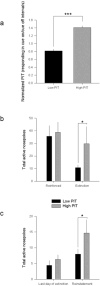Low prefrontal PSA-NCAM confers risk for alcoholism-related behavior
- PMID: 22922785
- PMCID: PMC3629946
- DOI: 10.1038/nn.3194
Low prefrontal PSA-NCAM confers risk for alcoholism-related behavior
Abstract
The factors underlying vulnerability to alcoholism are largely unknown. We identified in rodents an innate endophenotype predicting individual risk for alcohol-related behaviors that was associated with decreased expression of the neuroplasticity-related polysialylated neural cell adhesion molecule (PSA-NCAM). Depletion of PSA-NCAM in the ventromedial prefrontal cortex was sufficient to render mice unable to extinguish alcohol seeking, indicating a causal role of naturally occurring variation. These data suggest a mechanism of aberrant prefrontal neuroplasticity that underlies enhanced propensity for inflexible addiction-related behavior.
Figures


References
Publication types
MeSH terms
Substances
Grants and funding
LinkOut - more resources
Full Text Sources
Medical
Research Materials
Miscellaneous

